Diagnosis of Protected Agriculture in Imbabura—Ecuador, Period 2016–2023
Abstract
1. Introduction
2. Materials and Methods
2.1. Description of the Study Area
2.2. Estimation of the Productive Surface in Greenhouses
2.3. Construction Characteristics of the Greenhouses and Technical, Productive and Economic Aspects of the Tomato (Solanum lycopersicum L.)
3. Results
3.1. Spatial Distribution of the Productive Surface Under Plastic in Imbabura
3.2. Characteristics of the Agricultural Production Units (UPAs) That Have Fruit and Vegetable Greenhouses
3.3. Typology of Horticultural Greenhouses in the Province of Imbabura
3.4. Descriptive Characteristics of Fruit and Vegetable Greenhouses in Imbabura
3.5. Main Crops Present in Fruit and Vegetable Greenhouses
3.6. Management of Tomato Under Plastic in Imbabura
3.7. Productive and Economic Indicators of Tomato
3.8. Endogenous Characteristics of Protected Agriculture Producers
4. Discussion
5. Conclusions
Author Contributions
Funding
Data Availability Statement
Conflicts of Interest
Appendix A
| Bands | Name | Spatial Resolution (m) | Spectral Width (nm) |
|---|---|---|---|
| B1 | Aerosol | 60 | 443 |
| B2 | Blue | 10 | 490 |
| B3 | Green | 10 | 560 |
| B4 | Red | 10 | 665 |
| B5 | Near infrared | 20 | 705 |
| B6 | Near infrared | 20 | 740 |
| B7 | Near infrared | 20 | 783 |
| B8 | Near infrared | 10 | 842 |
| B8A | Near infrared | 20 | 865 |
| B9 | Water steam | 60 | 9.945 |
| B10 | Cirrus | 60 | 1.375 |
| B11 | Mid infrared | 20 | 1.610 |
| B12 | Mid infrared | 20 | 2.190 |
Appendix B
| Detail | Unit | Quantity | Unit Value | Total Value |
|---|---|---|---|---|
| A. Direct Costs | ||||
| Soil preparation | Ha | x | $x | $xx |
| Labor | Hours | x | $x | $xx |
| Supplies | Kg/ha | x | $x | $xx |
| Marketing | USD | x | $x | $xx |
| B. Indirect Costs | ||||
| Land rent per cycle | Ha | x | $x | $xx |
| Depreciation of infrastructure/equipment | Cycle | x | $x | $xx |
| Interest on credit | % | x | $x | $xx |
| Administrative expenses | Fixed | x | $x | $xx |
| TOTAL COSTS (A + B) |
References
- Wu, F.; Guan, Z.; Huang, K.-M. Protected Agriculture in Mexico: FE1124, 12/2022. EDIS 2022, 2022, 1–7. [Google Scholar] [CrossRef]
- Marín-Garcia, E.; Torres-Marín, J.-N.; Chaverra-Lasso, A. Smart Greenhouse and Agriculture 4.0. Rev. Cient. 2023, 46, 37–50. [Google Scholar] [CrossRef]
- Aidat, T.; Benziouche, S.E.; Cei, L.; Giampietri, E.; Berti, A. Impact of Agricultural Policies on the Sustainable Greenhouse Development in Biskra Region (Algeria). Sustainability 2023, 15, 14396. [Google Scholar] [CrossRef]
- RaboResearch. The 2018 World Vegetable Map. Rabobank Research Food & Agribusiness. 2018. Available online: https://research.rabobank.com/far/en/sectors/regional-food-agri/world_vegetable_map_2018.html (accessed on 7 October 2024).
- Costa, J.M.; Heuvelink, E.; Botden, N. (Eds.) Greenhouse Horticulture in China: Situation and Prospects; Ponsen & Looijen BV: Wageningen, The Netherlands, 2004; 140p. [Google Scholar]
- FAO. Unlocking the Potential of Protected Agriculture in the Countries of the Gulf Cooperation Council—Saving Water and Improving Nutrition; FAO: Cairo, Egypt, 2021. [Google Scholar]
- Sun, H.; Wang, L.; Lin, R.; Zhang, B. Mapping Plastic Greenhouses with Two-Temporal Sentinel-2 Images and 1D-CNN Deep Learning. Remote Sens. 2021, 13, 2820. [Google Scholar] [CrossRef]
- Agroplastic Community. Increase in Protected Agriculture in the World—Agriplastics Community. 2023. Available online: https://agriplasticscommunity.com/increase-in-protected-agriculture/ (accessed on 22 December 2024).
- Ministerio de Agricultura y Ganadería. Panorama Agroestadístico. Enero 2024. 2024. Available online: http://sipa.agricultura.gob.ec/index.php/panorama-agroestadistico/2024-panorama-agroestadistico (accessed on 27 March 2024).
- Banco Central del Ecuador. Reporte de Coyuntura sector Agropecuario Diciembre 2021; Banco Central del Ecuador: Quito, Ecuador, 2023. [Google Scholar]
- Zavala, V. Caracterización y uso Eficiente de la Energía Solar en Sistemas Hortícolas Intensivos de Ecuador. Ph.D. Thesis, Universidad de Almería—España, Almería, Spain, 2021. Available online: https://repositorio.ual.es/bitstream/handle/10835/12673/01.%20Tesis.pdf?sequence=1&isAllowed=y (accessed on 19 September 2024).
- Henao, F. Plasticultura en el Agro. 2000. Available online: http://hoy.tawsa.com/noticias-ecuador/plasticultura-en-el-agro-47071.html (accessed on 21 September 2024).
- Arredondo Navarro, E.; Franco Rodríguez, J.; Lao Arenas, M.; Llanderal, A. Estudio de las Condiciones Agroclimáticas en la Costa del Ecuador, 1st ed.; Dirección de Publicaciones de la Universidad Católica de Santiago de Guayaquil: Guayaquil, Ecuador, 2022; 135p. [Google Scholar]
- Prefectura Imbabura. Plan de Desarrollo y Ordenamiento Territorial de la Provincia de Imbabura (2015–2035); Prefectura Imbabura: Ibarra, Ecuador, 2018. [Google Scholar]
- Ministerio de Agricultura y Ganadería. Sistema de Información Pública Agropecuaria. Cifras Agroproductivas. 2024. Available online: http://sipa.agricultura.gob.ec/index.php/cifras-agroproductivas (accessed on 24 October 2024).
- Villagrán, E.; Flores-Velazquez, J.; Akrami, M.; Bojacá, C. Microclimatic Evaluation of Five Types of Colombian Greenhouses Using Geostatistical Techniques. Sensors 2022, 22, 3925. [Google Scholar] [CrossRef] [PubMed]
- Bouzo, C.A.; Gariglio, N.F.; Favaro, J.C.; Candiotti, N.V. Caracterización y análisis técnico de los invernaderos en las provincias de Córdoba y Santa Fe. Hortic. Argent. 2009, 28, 24–36. [Google Scholar]
- Lozano-Povis, A.; Alvarez-Montalván, C.E.; Moggiano, N. REVIEW Climate change in the Andes and its impact on agriculture: A systematic review. Sci. Agropecu. 2021, 12, 101–108. [Google Scholar] [CrossRef]
- Aznar-Sánchez, J.A.; Velasco-Muñoz, J.F.; López-Felices, B.; Román-Sánchez, I.M. An analysis of global research trends on greenhouse technology: Towards a sustainable agriculture. Int. J. Environ. Res. Public Health 2020, 17, 664. [Google Scholar] [CrossRef] [PubMed]
- Lawrence, J.; Simpson, L.; Piggott, A. Protected agriculture: A climate change adaptation for food and nutrition security. In Natural Resources Management: Concepts, Methodologies, Tools, and Applications; IGI Global: Hershey, PA, USA, 2016; Volumes 1–2. [Google Scholar] [CrossRef]
- McCartney, L.; Lefsrud, M.G. Protected agriculture in extreme environments: A review of controlled environment agriculture in Tropical, arid, polar, and urban locations. Appl. Eng. Agric. 2018, 34, 455–473. [Google Scholar] [CrossRef]
- Omar, S.A. Protected agricultural production in Kuwait. Acta Hortic. 2004, 659, 87–94. [Google Scholar] [CrossRef]
- Wang, Y. Present situation and countermeasures of protected agriculture of Turpan city in Xinjiang Uygur Autonomous Region. Nongye Gongcheng Xuebao/Trans. Chin. Soc. Agric. Eng. 2005, 21 (Suppl. S2), 227–228. [Google Scholar]
- Chavan, S.G.; Chen, Z.-H.; Ghannoum, O.; Cazzonelli, C.I.; Tissue, D.T. Current Technologies and Target Crops: A Review on Australian Protected Cropping. Crops 2022, 2, 172–185. [Google Scholar] [CrossRef]
- Kumar, P.; Kar, A.; Singh, D.R.; Perumal, A.; Shivamurthy, S.G.C.; Reddy, K.V.; Badal, P.S.; Lala Kamble, A.; Kamalvanshi, V.; Jha, G.K.; et al. Protected cultivation of horticultural crops in uttarakhand: An economic analysis. Agronomy 2021, 11, 692. [Google Scholar] [CrossRef]
- Blanco, I.; Luvisi, A.; de Bellis, L.; Schettini, E.; Vox, G.; Scarascia Mugnozza, G. Research Trends on Greenhouse Engineering Using a Science Mapping Approach. Horticulturae 2022, 8, 833. [Google Scholar] [CrossRef]
- Abdelmadjid, M.K.; Noureddine, S.; Amina, B.; Khelifa, B.; Tariq, B.; Boubakeur, L. IoT and WSNs Technology for Control in the Greenhouse Agriculture-Review. In Proceedings of the 2022 3rd International Conference on Embedded and Distributed Systems, EDiS, Oran, Algeria, 2–3 November 2022. [Google Scholar] [CrossRef]
- Kavga, A.; Thomopoulos, V.; Barouchas, P.; Stefanakis, N.; Liopa-Tsakalidi, A. Research on innovative training on smart greenhouse technologies for economic and environmental sustainability. Sustainability 2021, 13, 536. [Google Scholar] [CrossRef]
- Ghani, S.; Bakochristou, F.; ElBialy, E.M.A.A.; Gamaledin, S.M.A.; Rashwan, M.M.; Abdelhalim, A.M.; Ismail, S.M. Design challenges of agricultural greenhouses in hot and arid environments—A review. Eng. Agric. Environ. Food 2019, 12, 48–70. [Google Scholar] [CrossRef]
- Kozai, T.; Kubota, C.; Takagaki, M.; Maruo, T. Greenhouse environment control technologies for improving the sustainability of food production. Acta Hortic. 2015, 1107, 1–14. [Google Scholar] [CrossRef]
- Aguilar, M.A.; Jiménez-Lao, R.; Aguilar, F.J. Evaluation of Object-Based Greenhouse Mapping Using WorldView-3 VNIR and SWIR Data: A Case Study from Almería (Spain). Remote Sens. 2021, 13, 2133. [Google Scholar] [CrossRef]
- Aguilar, M.A.; Jiménez-Lao, R.; Ladisa, C.; Aguilar, F.J.; Tarantino, E. Comparison of spectral indices extracted from Sentinel-2 images to map plastic covered greenhouses through an object-based approach. GISci. Remote Sens. 2022, 59, 822–842. [Google Scholar] [CrossRef]
- Li, J.; Zhang, L.; Shen, Y.; Li, X.; Liu, W.; Chai, Q.; Zhang, R.; Chen, D. Object-Based Mapping of Plastic Greenhouses with Scattered Distribution in Complex Land Cover Using Landsat 8 OLI Images: A Case Study in Xuzhou, China. J. Indian Soc. Remote Sens. 2020, 48, 287–303. [Google Scholar] [CrossRef]
- Senel, G.; Aguilar, M.A.; Aguilar, F.J.; Nemmaoui, A.; Goksel, C. A Comprehensive Benchmarking of the Available Spectral Indices Based on Sentinel-2 for Large-Scale Mapping of Plastic-Covered Greenhouses. IEEE J. Sel. Top. Appl. Earth Obs. Remote Sens. 2023, 16, 6601–6613. [Google Scholar] [CrossRef]
- Valera Martinez, D.L.; Belmonte Ureña, L.J.; Domingo Molina Aiz, F.; Loópez Martinez, A. Los invernaderos de Almería. Análisis de su Tecnología y Rentabilidad; Economía; Cajamar Caja Rural: Almería, Spain, 2014. [Google Scholar]
- Maureira, F.; Rajagopalan, K.; Stöckle, C.O. Evaluating tomato production in open-field and high-tech greenhouse systems. J. Clean. Prod. 2022, 337, 130459. [Google Scholar] [CrossRef]
- Ward, W.A. Cost-Benefit Analysis Theory versus Practice at the World Bank 1960 to 2015. J. Benefit-Cost Anal. 2019, 10, 124–144. [Google Scholar] [CrossRef]
- He, Y.; Luo, S.; Zha, Y.; Jiang, X.; Wang, X.; Chen, H.; Han, S. Impacts of Multi-Strategy Nitrogen Fertilizer Management on Potato Yield and Economic Gains in Northeast China. Agronomy 2023, 13, 2920. [Google Scholar] [CrossRef]
- Song, X.P.; Potapov, P.V.; Krylov, A.; King, L.A.; di Bella, C.M.; Hudson, A.; Khan, A.; Adusei, B.; Stehman, S.V.; Hansen, M.C. National-scale soybean mapping and area estimation in the United States using medium resolution satellite imagery and field survey. Remote Sens. Environ. 2017, 190, 383–395. [Google Scholar] [CrossRef]
- Tiwari, A.; Silver, M.; Karnieli, A. Developing object-based image procedures for classifying and characterising different protected agriculture structures using LiDAR and orthophoto. Biosyst. Eng. 2020, 198, 91–104. [Google Scholar] [CrossRef]
- Mendoza-Fernández, A.J.; Peña-Fernández, A.; Molina, L.; Aguilera, P.A. The role of technology in greenhouse agriculture: Towards a sustainable intensification in campo de dalías (Almería, Spain). Agronomy 2021, 11, 101. [Google Scholar] [CrossRef]
- Marcelis, L.F.M.; Heuvelink, E. Achieving Sustainable Greenhouse Cultivation; Burleigh Dodds Science Publishing Limited: Cambridge, UK, 2019. [Google Scholar] [CrossRef]
- Perilla, G.A.; Mas, J.F. High-resolution mapping of protected agriculture in Mexico, through remote sensing data cloud geoprocessing. Eur. J. Remote Sens. 2019, 52, 532–541. [Google Scholar] [CrossRef]
- Korthals Altes, W.K.; van Rij, E. Planning the horticultural sector: Managing greenhouse sprawl in the Netherlands. Land Use Policy 2013, 31, 486–497. [Google Scholar] [CrossRef]
- Instituto Nacional de Estadísticas y Censos (INEC). Perfil Agropecuario Provincial del Ecuador. 2008. Available online: https://www.ecuadorencifras.gob.ec/documentos/web-inec/Bibliotecas/Estudios/Estudios_Economicos/Perfil_Agropecuario_2008.pdf (accessed on 27 March 2024).
- Leon Paz, J.R.; Rivera, A. Ilegalidad de la tenencia y desigualdad en la distribución de la tierra en Ecuador como condiciones de vulnerabilidad. Geopauta 2020, 4, 34–48. [Google Scholar] [CrossRef]
- Kutlar, I. Analysis of the sources of agricultural information available to greenhouse tomato growers in Turkey. Fresenius Environ. Bull. 2019, 28, 6825–6835. [Google Scholar]
- Lenscak, M.P.; Iglesias, N. Invernaderos: Tecnología Apropiada en las Regiones Productivas del Territorio Nacional Argentino (del Paralelo 23 al 54); INTA Ediciones: Colección, Spain, 2019. [Google Scholar]
- Stanghellini, C.; van’t Ooster, B.; Heuvelink, E. Greenhouse Horticulture; Brill: Leiden, The Netherlands, 2019. [Google Scholar] [CrossRef]
- Syed, A.M.; Hachem, C. Review of Construction; Geometry; Heating, Ventilation, and Air-Conditioning; and Indoor Climate Requirements of Agricultural Greenhouses. J. Biosyst. Eng. 2019, 44, 18–27. [Google Scholar] [CrossRef]
- Rojas-Rishor, A.; Flores-Velazquez, J.; Villagran, E.; Aguilar-Rodríguez, C.E. Valuation of Climate Performance of a Low-Tech Greenhouse in Costa Rica. Processes 2022, 10, 693. [Google Scholar] [CrossRef]
- Moreno-Teruel, M.d.l.Á.; Molina-Aiz, F.D.; Peña-Fernández, A.; López-Martínez, A.; Valera-Martínez, D.L. The effect of diffuse film covers on microclimate and growth and production of tomato (Solanum lycopersicum L.) in a mediterranean greenhouse. Agronomy 2021, 11, 860. [Google Scholar] [CrossRef]
- Sun, W.; Wei, X.; Zhou, B.; Lu, C.; Guo, W. Greenhouse heating by energy transfer between greenhouses: System design and implementation. Appl. Energy 2022, 325, 119815. [Google Scholar] [CrossRef]
- Rocha, G.A.O.; Pichimata, M.A.; Villagran, E. Research on the microclimate of protected agriculture structures using numerical simulation tools: A technical and bibliometric analysis as a contribution to the sustainability of under-cover cropping in tropical and subtropical countries. Sustainability 2021, 13, 433. [Google Scholar] [CrossRef]
- Villagrán, E.; Flores-Velazquez, J.; Akrami, M.; Bojacá, C. Influence of the height in a Colombian multi-tunnel greenhouse on natural ventilation and thermal behavior: Modeling approach. Sustainability 2021, 13, 13631. [Google Scholar] [CrossRef]
- Reynafarje, X.; Villagrán, E.A.; Bojacá, C.R.; Gil, R.; Schrevens, E. Simulation and validation of the airflow inside a naturally ventilated greenhouse designed for tropical conditions. Acta Hortic. 2020, 1271, 55–62. [Google Scholar] [CrossRef]
- Villagrán, E.A.; Baeza Romero, E.J.; Bojacá, C.R. Transient CFD analysis of the natural ventilation of three types of greenhouses used for agricultural production in a tropical mountain climate. Biosyst. Eng. 2019, 188, 288–304. [Google Scholar] [CrossRef]
- Badji, A.; Benseddik, A.; Bensaha, H.; Boukhelifa, A.; Hasrane, I. Design, technology, and management of greenhouse: A review. J. Clean. Prod. 2022, 373, 133753. [Google Scholar] [CrossRef]
- Katzin, D.; van Henten, E.J.; van Mourik, S. Process-based greenhouse climate models: Genealogy, current status, and future directions. Agric. Syst. 2022, 198, 103388. [Google Scholar] [CrossRef]
- Moons, I.; de Pelsmacker, P.; Pijnenburg, A.; Daems, K.; van de Velde, L.L.J. Growers’ adoption intention of innovations is crucial to establish a sustainable greenhouse horticultural industry: An empirical study in Flanders and the Netherlands. J. Clean. Prod. 2022, 330, 129752. [Google Scholar] [CrossRef]
- Rustia, D.J.A.; Lin, C.E.; Chung, J.Y.; Zhuang, Y.J.; Hsu, J.C.; Lin, T.T. Application of an image and environmental sensor network for automated greenhouse insect pest monitoring. J. Asia-Pac. Entomol. 2020, 23, 17–28. [Google Scholar] [CrossRef]
- Yuan, B.Z.; Kang, Y.; Nishiyama, S. Drip irrigation scheduling for tomatoes in unheated greenhouses. Irrig. Sci. 2001, 20, 149–154. [Google Scholar] [CrossRef]
- Londra, P.A.; Gkolfinopoulou, P.; Mponou, A.; Theocharis, A.T. Effect of Rainfall Regime on Rainwater Harvesting Tank Sizing for Greenhouse Irrigation Use. Hydrology 2022, 9, 122. [Google Scholar] [CrossRef]
- Colimba-Limaico, J.E.; Zubelzu-Minguez, S.; Rodríguez-Sinobas, L. Optimal Irrigation Scheduling for Greenhouse Tomato Crop (Solanum lycopersicum L.) in Ecuador. Agronomy 2022, 12, 1020. [Google Scholar] [CrossRef]
- Li, Y.; Chen, Y.; Li, J.; Sun, Q.; Li, J.; Xu, J.; Liu, B.; Lang, Q.; Qiao, Y. Organic management practices enhance soil food web biomass and complexity under greenhouse conditions. Appl. Soil Ecol. 2021, 167, 104010. [Google Scholar] [CrossRef]
- Plaza, B.M.; Lao, M.T.; Jiménez-Becker, S. Fertigation Strategies to Alleviate Fertilizer Contamination Generated by Tomato Crops under Plastic Greenhouses. Agronomy 2021, 11, 444. [Google Scholar] [CrossRef]
- Castillo-Pérez, B.; y Castillo-Bermeo, V. Use of chemical pesticides on tomato (Solanum lycopersicum L.) under greenhouse and field conditions in Loja, Ecuador. Rev. Cent. Estud. Desarro. Amazonia 2021, 11, 22–41. Available online: https://revistas.unl.edu.ec/index.php/cedamaz/article/view/1034/781 (accessed on 23 October 2024).
- Liu, W.; Tian, S.; Wang, Q.; Jiang, H. Key Technologies of Plug Tray Seedling Transplanters in Protected Agriculture: A Review. Agriculture 2023, 13, 1488. [Google Scholar] [CrossRef]
- Gong, X.; Li, X.; Qiu, R.; Bo, G.; Ping, Y.; Xin, Q.; Ge, J. Ventilation and irrigation management strategy for tomato cultivated in greenhouses. Agric. Water Manag. 2022, 273, 107908. [Google Scholar] [CrossRef]
- Costa, J.M.; Heuvelink, E. Introduction: The tomato crop and industry. In Tomatoes; CABI Publishing: Wallingford, UK, 2005. [Google Scholar] [CrossRef]
- Berrueta, C.; Borges, A.; Giménez, G.; Dogliotti, S. On-farm diagnosis for greenhouse tomato in south Uruguay: Explaining yield variability and ranking of determining factors. Eur. J. Agron. 2019, 110, 125932. [Google Scholar] [CrossRef]
- Foley, J.A.; Ramankutty, N.; Brauman, K.A.; Cassidy, E.S.; Gerber, J.S.; Johnston, M.; Mueller, N.D.; O’Connell, C.; Ray, D.K.; West, P.C.; et al. Solutions for a cultivated planet. Nature 2011, 478, 337–342. [Google Scholar] [CrossRef] [PubMed]
- Mirzamohammadi, S.; Jabarzadeh, A.; Shahrabi, M.S. Long-term planning of supplying energy for greenhouses using renewable resources under uncertainty. J. Clean. Prod. 2020, 264, 121611. [Google Scholar] [CrossRef]
- Guo, Y.; Zhao, H.; Zhang, S.; Wang, Y.; Chow, D. Modeling and optimization of environment in agricultural greenhouses for improving cleaner and sustainable crop production. J. Clean. Prod. 2021, 285, 124843. [Google Scholar] [CrossRef]
- Cama-Pinto, D.; Damas, M.; Holgado-Terriza, J.A.; Arrabal-Campos, F.M.; Martínez-Lao, J.A.; Cama-Pinto, A.; Manzano-Agugliaro, F. A Deep Learning Model of Radio Wave Propagation for Precision Agriculture and Sensor System in Greenhouses. Agronomy 2023, 13, 244. [Google Scholar] [CrossRef]
- van Straten, G.; van Willigenburg, G.; van Henten, E.; van Ooteghem, R. Optimal Control of Greenhouse Cultivation; CRC Press: Boca Raton, FL, USA, 2010. [Google Scholar] [CrossRef]
- Encuesta de Superficie y Producción Agropecuaria Continua. Módulo Económico, Reporte a Junio 2022. 2019. Available online: https://www.ecuadorencifras.gob.ec/documentos/web-inec/Encuestas_Ambientales/Modulo_economico_ESPAC/2019/Presentaci%C3%B3n%20de%20resultados%20ESPAC_ECO_2019.pdf (accessed on 23 July 2024).
- Daza, E.; Artacker, T.; Lizano, R. Cambio Climático, Biodiversidad y Sistemas Agroalimentarios: Avances y Retos a 10 años de la Ley Orgánica del Régimen de la Soberanía Alimentaria en Ecuador; Editorial Abya-Yala: Quito, Ecuador, 2020; 296p, ISBN 978-9978-10-466-8. [Google Scholar] [CrossRef]
- Neimark, B.; Osterhoudt, S.; Alter, H.; Gradinar, A. A new sustainability model for measuring changes in power and access in global commodity chains: Through a smallholder lens. Palgrave Commun. 2019, 5, 1. [Google Scholar] [CrossRef]
- Franco-Crespo, C.; Carrasco, L.V.M.; Aimacaña, N.R.L.; Chávez, G.A.C. Small-farmers dynamics in the sierra of Ecuador. Granja 2019, 30, 94–110. [Google Scholar] [CrossRef]
- Instituto Nacional de Estadísticas y Censos (INEC). Encuesta de Superficie y Producción Agropecuaria Contínua. Estadísticas Agropecuarias. 2022. Available online: https://www.ecuadorencifras.gob.ec/estadisticas-agropecuarias-2/ (accessed on 27 March 2024).
- Boncinelli, F.; Bartolini, F.; Casini, L.; Brunori, G. On farm non-agricultural activities: Geographical determinants of diversification and intensification strategy. Lett. Spat. Resour. Sci. 2017, 10, 17–29. [Google Scholar] [CrossRef]
- Vargas-Canales, J.M.; Palacios-Rangel, I.; Carlos García-Cruz, J.; Huitzilihuitl Camacho-Vera, J.; Sánchez-Torres, Y.; Simón-Calderón, C.; Simón, C.; Camacho-Vera, J.H. Analysis of the impact of the regional innovation system of protected agriculture in Hidalgo. J. Agric. Educ. Ext. 2023, 29, 269–294. [Google Scholar] [CrossRef]
- Barati, A.A.; Azadi, H.; Movahhed Moghaddam, S.; Scheffran, J.; Dehghani Pour, M. Agricultural expansion and its impacts on climate change: Evidence from Iran. Environ. Dev. Sustain. 2024, 26, 5089–5115. [Google Scholar] [CrossRef]
- Qayyum, M.; Zhang, Y.; Wang, M.; Yu, Y.; Li, S.; Ahmad, W.; Maodaa, S.N.; Sayed, S.R.M.; Gan, J. Advancements in technology and innovation for sustainable agriculture: Understanding and mitigating greenhouse gas emissions from agricultural soils. J. Environ. Manag. 2023, 347, 119147. [Google Scholar] [CrossRef] [PubMed]
- Kollar, A.J. Bridging the gap between agriculture and climate: Mitigation of nitrous oxide emissions from fertilizers. Environ. Prog. Sustain. Energy 2023, 42, e14069. [Google Scholar] [CrossRef]
- Farooq, M.S.; Riaz, S.; Helou, M.A.; Khan, F.S.; Abid, A.; Alvi, A. Internet of Things in Greenhouse Agriculture: A Survey on Enabling Technologies, Applications, and Protocols. IEEE Access 2022, 10, 53374–53397. [Google Scholar] [CrossRef]

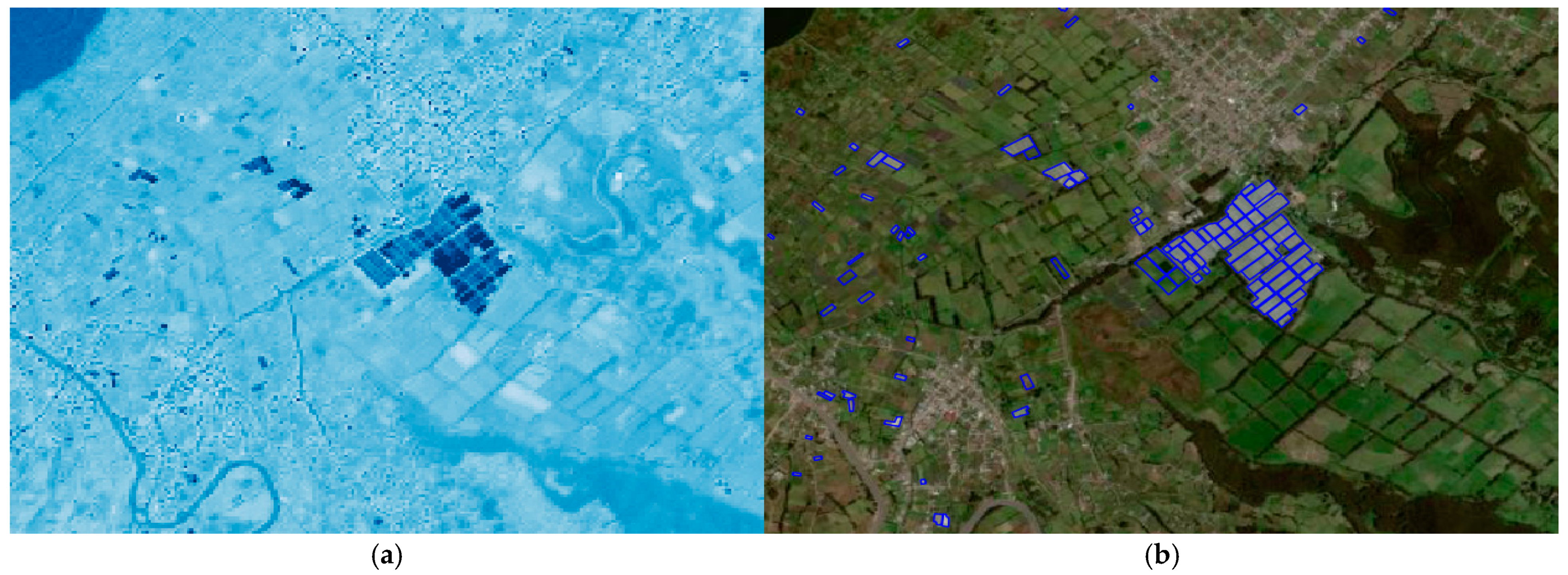

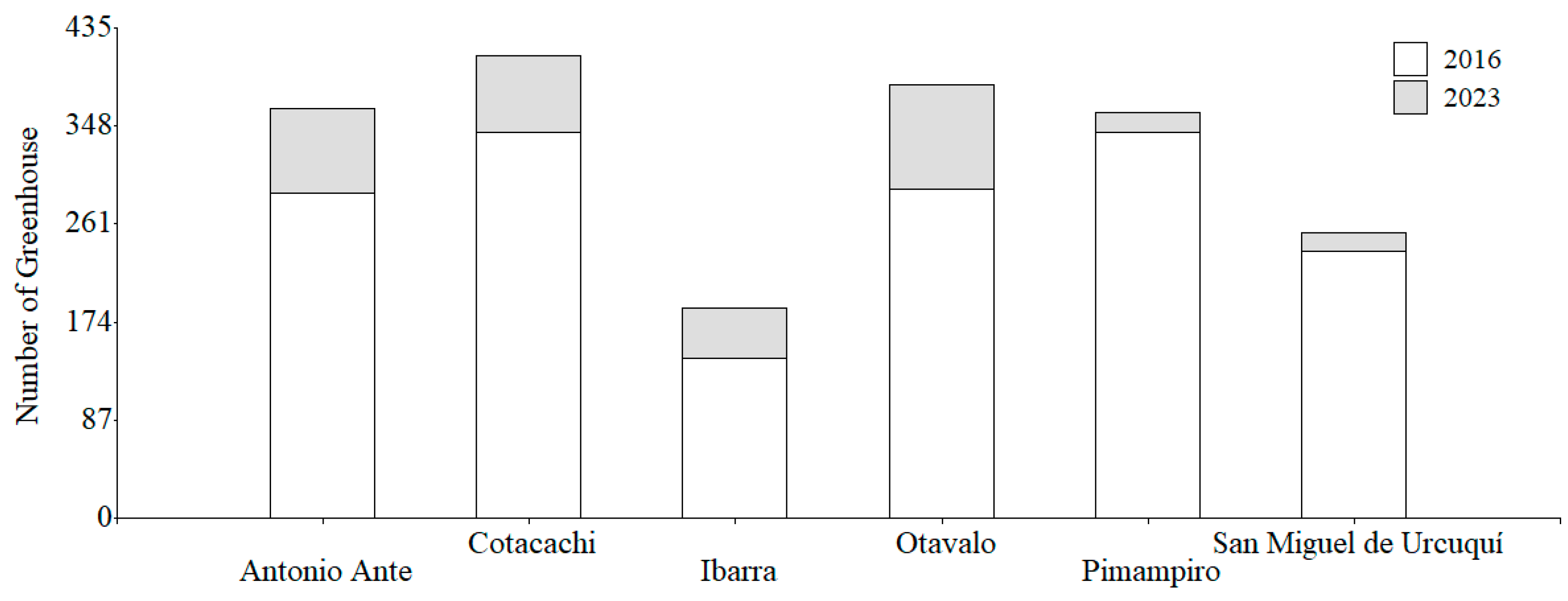
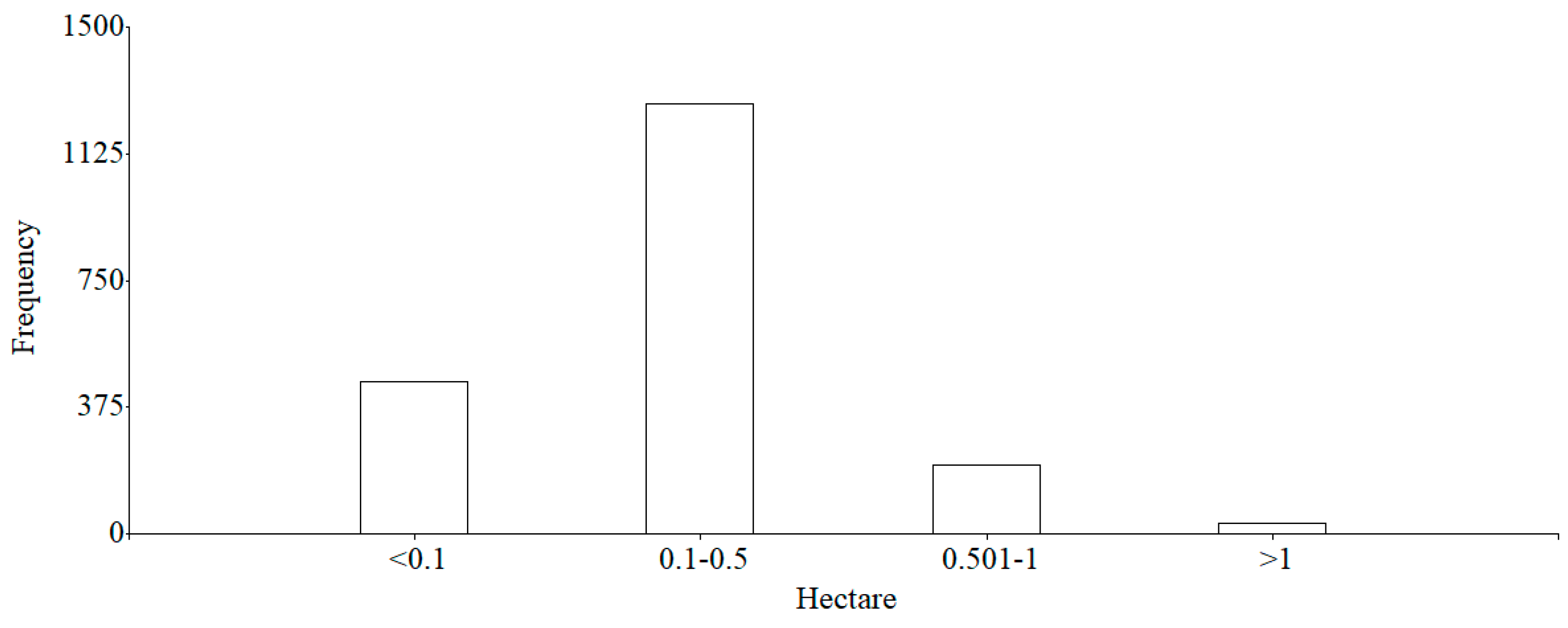
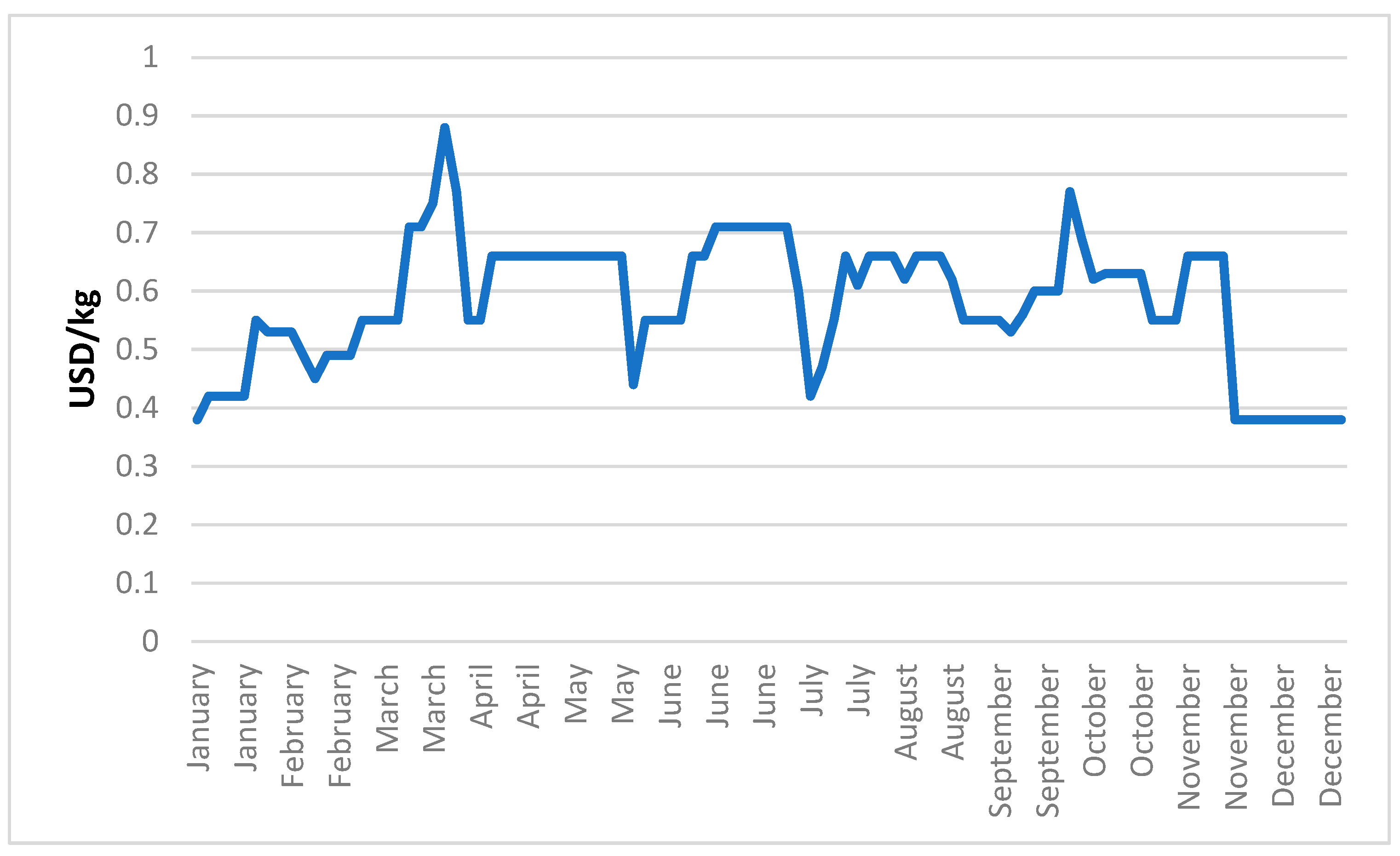

| Characteristics | Parameters | ||
|---|---|---|---|
| Own | Leased | At the beginning | |
| Land ownership (%) | 68.8 | 24.8 | 6.4 |
| Frequency of water availability (%) | Diary | Weekly | Biweekly |
| 32.9 | 43.6 | 23.5 | |
| No. greenhouses per farm | Minimum | Maximum | Media |
| 1 | 10 | 2.3 | |
| Reservoir size in m3 (13% do not have) | 40 | 90 | 400 |
| Access roads to the farm (%) | Adequate | Not very suitable | |
| 91 | 9 | ||
| Access to basic services | Has | Does not have | |
| Waste collection (%) | 73.9 | 26.1 | |
| Electric light (%) | 86.8 | 13.2 | |
| Sewerage (%) | 65 | 35 | |
| Drinking water (%) | 84.6 | 15.4 | |
| Description | Type: Wood |
|---|---|
| The support structure is made of wood, eucalyptus is commonly used (Eucalyptus globulus Labill), with cemented posts. The roof is flat asymmetrical, with a zenithal opening, long-lasting polyethylene plastic cover and ventilation areas on all four sides. | 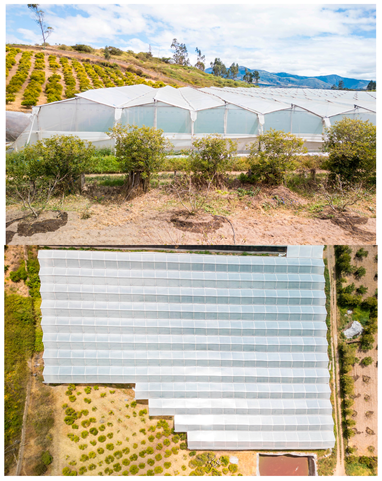 |
| Number of sections (n): 12 front and 8 rear Section width (m): 5.85 Total width (m): 70.2 front and 46.8 post Greenhouse length (m): 84 Covered area (m2): 4914 Zenith ventilation area (m2): 268.8 Side ventilation area (m2): 302.4 Front ventilation area (m2): 252.8 Total ventilation surface (m2): 824 Ventilation ratio (Stv/Sc, %): 16.7 %Minimum height (m): 4.23 Maximum height (m): 5.15 | |
Some authors can reference it with the following:
| |
| Description | Type: Metal |
| The entire structure is metal, with cemented posts. The roof is curved, with a zenith opening covered in long-lasting polyethylene plastic and ventilation areas on all four sides. | 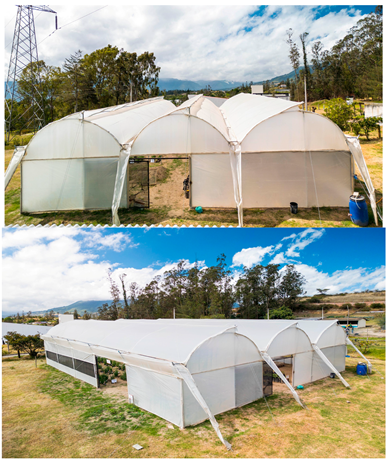 |
| Number of sections (n): 3 Section width (m): 5 Total width (m): 15 Greenhouse length (m): 20 Covered area (m2): 300 Zenith ventilation area (m2): 24 Side ventilation area (m2): 42 Front ventilation area (m2): 0 Total ventilation surface (m2): 66 Ventilation ratio (Stv/Sc, %): 22 %Minimum height (m): 4 Maximum height (m): 5 | |
Some authors can reference it with the following:
|
| CRITERION | Parameters | ||
|---|---|---|---|
| Greenhouse type (%) | Mixed 57.1 | Wood 19 | Metal 23.9 |
| Average construction cost (USD/m2) | 12.5 | 8 | 9 |
| Minimum | Maximum | Mean | |
| Greenhouse years | <1 | 30 | 5.3 |
| Plastic type (%) | Polyethylene without additives (PE) | Low density polyethylene (LDPE) | Long-lasting polyethylene (PEld) |
| 27.8 | 5.6 | 66.6 | |
| Natural | Artificial | ||
| Ventilation (%) | 100 | 0 | |
| Aspersion | Drip | Nebulization | |
| Irrigation system (%) | 0.8 | 99.2 | 0 |
| Has | Does not have | ||
| Insect mesh (%) | 42.3 | 57.7 | |
| Shading mesh (%) | 2.1 | 97.9 | |
| Fans (%) | 0 | 100 | |
| Nebulizers (%) | 0 | 100 | |
| Heaters (%) | 0 | 100 | |
| Temperature sensor (%) | 3.8 | 96.2 | |
| Humidity sensor (%) | 3.8 | 96.2 | |
| Makes | Not done | ||
| Collects rainwater (%) | 28.2 | 71.8 | |
| Greenhouse whitewashing (%) | 4.7 | 95.3 | |
| CRITERION | Parameters | ||
|---|---|---|---|
| Makes | Not done | ||
| Soil analysis (%) | 43.6 | 56.4 | |
| Leaf analysis (%) | 17.5 | 82.5 | |
| Water analysis (%) | 21.8 | 78.2 | |
| Renewal pruning (%) | 31.6 | 68.4 | |
| Soil disinfection (%) | Chemical | Biological | Not done |
| 75.2 | 8.1 | 16.7 | |
| Tractor | Manual | ||
| Land preparation (%) | 80.3 | 19.7 | |
| Organic | Chemical | ||
| Soil fertilization (%) | 19.7 | 80.3 | |
| Direct (seed) | Own seedlings | Acquired seedlings | |
| Planting method (%) | 2.6 | 5.1 | 92.3 |
| Orientation of crop lines (%) | Longitudinal | Transversal | |
| 46.6 | 53.4 | ||
| Substratum | Floor_bed | Soil_furrow | |
| Production means (%) | 6.4 | 59.4 | 34.2 |
| No. Permanent workers (%) | Minimum | Maximum | Mean |
| 1 | 20 | 2.91 | |
| No. Casual workers (%) | 0 | 20 | 4.51 |
| Biological only | just chemical | Mixed | |
| Disease Control (%) | 1.3 | 74.4 | 24.3 |
| Pest control (%) | 1.3 | 76.9 | 21.8 |
| Monitor pests and diseases (%) | And | No | |
| 83.3 | 16.7 | ||
| Fertirriego only | Foliar only | Mixed | |
| Method of fertilizing (%) | 67.1 | 6.8 | 26.1 |
| Bioinsumos | Chemical | Mixed | |
| Inputs to fertilize (%) | 3.8 | 38.5 | 57.7 |
| Automated | Manual | ||
| Irrigation (%) | 27.8 | 72.2 | |
| Manual | Chemical | ||
| Weed Control (%) | 65 | 35 | |
| Bees | Natural (air) | ||
| Pollination (%) | 6.4 | 93.6 | |
| Variable | Mean | S.D |
|---|---|---|
| Yield (kg·m−2) | 12.07 | 4.07 |
| Total cost (USD·ha−1) | 47,249.46 | 1685.88 |
| Income (USD·ha−1) | 60,372.45 | 2037.58 |
| Gross profit (USD·ha−1) | 13,122.99 | 1806.86 |
| C/B ratio | 1.6 | 0.86 |
Disclaimer/Publisher’s Note: The statements, opinions and data contained in all publications are solely those of the individual author(s) and contributor(s) and not of MDPI and/or the editor(s). MDPI and/or the editor(s) disclaim responsibility for any injury to people or property resulting from any ideas, methods, instructions or products referred to in the content. |
© 2025 by the authors. Licensee MDPI, Basel, Switzerland. This article is an open access article distributed under the terms and conditions of the Creative Commons Attribution (CC BY) license (https://creativecommons.org/licenses/by/4.0/).
Share and Cite
Albuja-Illescas, L.M.; Carrión-Burgos, A.M.; Jiménez-Lao, R.; Lao, M.T. Diagnosis of Protected Agriculture in Imbabura—Ecuador, Period 2016–2023. Agronomy 2025, 15, 166. https://doi.org/10.3390/agronomy15010166
Albuja-Illescas LM, Carrión-Burgos AM, Jiménez-Lao R, Lao MT. Diagnosis of Protected Agriculture in Imbabura—Ecuador, Period 2016–2023. Agronomy. 2025; 15(1):166. https://doi.org/10.3390/agronomy15010166
Chicago/Turabian StyleAlbuja-Illescas, Luis Marcelo, Andrés Manolo Carrión-Burgos, Rafael Jiménez-Lao, and María Teresa Lao. 2025. "Diagnosis of Protected Agriculture in Imbabura—Ecuador, Period 2016–2023" Agronomy 15, no. 1: 166. https://doi.org/10.3390/agronomy15010166
APA StyleAlbuja-Illescas, L. M., Carrión-Burgos, A. M., Jiménez-Lao, R., & Lao, M. T. (2025). Diagnosis of Protected Agriculture in Imbabura—Ecuador, Period 2016–2023. Agronomy, 15(1), 166. https://doi.org/10.3390/agronomy15010166








